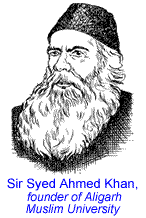
Dimdima
Online Children's Magazine from India

Dimdima
Online Children's Magazine from India
| The Great Divide |
|
By the time the British arrived in India, Muslims had become sons of the soil.
They were no longer outsiders. India was their home and they knew no other. |
The Hindu-Muslim equation underwent a qualitative change due to three factors:
English education, employment in government services and the British policy of Divide and Rule.
in government services and the British policy of Divide and Rule.
The new system of administration introduced by the British was linked to English
education which the Hindus took to and to which Muslims remained indifferent.
Between the founding of Hindu College in Calcutta in 1817 and Aligarh Muslim
University, there was a gap of about sixty years. During this period the
government was also wary of giving jobs to Muslims whom it held responsible for
the events of 1857. Thus education and employment created a gulf between the two
communities. As more and more people competed for government jobs, Hindus and
Muslims could not but become aware of their separate identities and by the
beginning of the 20th century, leaders of both communities began to take steps
to safeguard the interests of their own people.
So it was that Sir Syed Ahmed Khan urged his people to keep off agitational
politics that could make the administration suspect their loyalty. This gave the
government a chance to play one community against the other. Lord Curzon, for
instance, went out of his way to point out the advantages Muslims would have
with the formation of the new state of East Bengal and Assam. "The province so
created", declared the Viceroy in a speech in Dacca, "…would invest the
Mohammedans in Eastern Bengal with a unity which they have not enjoyed since the
days of the old Musalman Viceroys and Kings…"
Fuller who took over as the Lieutenant-Governor of the newly created East Bengal
said with reference to the two sections of the population, Muslims and Hindus,
that they were like his two queens, the first being the suo the favoured and the
second the duo the neglected.
In 1906, a section of the Muslim community formed the Muslim League to safeguard
what the organisers called the Muslim interest. While the Indian National
Congress claimed to represent the people of India — Hindus, Muslims, Sikhs and
all — the Muslim League maintained that the league alone represented Muslim
interests. While a few organizations claiming to represent the Hindus or Sikhs
did come into existence none of them reached the level of importance of the
Muslim League.
Thus, even as India was emerging as a nation at the beginning of this century,
forces of disintegration were forming at the same time.
Dimdima is the Sanskrit word for ‘drumbeat’. In olden days, victory in battle was heralded by the beat of drums or any important news to be conveyed to the people used to be accompanied with drumbeats.
Bharatiya Vidya Bhavan
K. M Munshi Marg,
Chowpatty, Mumbai - 400 007
email : editor@dimdima.com
Bharatiya Vidya Bhavan
505, Sane Guruji Marg,
Tardeo, Mumbai - 400 034
email : promo@dimdima.com
Dimdima.com, the Children's Website of Bharatiya Vidya Bhavan launched in 2000 and came out with a Printed version of Dimdima Magazine in 2004. At present the Printed Version have more than 35,000 subscribers from India and Abroad.